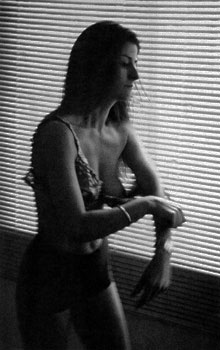Henry Bond
Emily Tsingou, London
Art Monthly, Issue 217, Jun 1998

Image: Henry Bond, The Cult of the Street
Just as there are bad paintings, so there are bad photographs too. I mean bad as in not very well done, according to the prevailing conventions. It is this very conventionality that is recognised and challenged in the production of deliberately bad works. Obviously, then, bad is an ethnic term, insofar as its determining factors vary from cultural group to cultural group. One man's meat is another man's poison, and all that. So bad, then, can actually mean good - as was memorably explained by John Craven's Newsround when Michael Jackson returned to the album charts.
All of this, of course, is exactly Henry Bond's point: values and meanings are constantly on the slide, be they the meaning of wearing brown instead of black, Airwalk instead of Airmax or including the subject's shoes in full-length photographs instead of cropping them. Bond sets out to document these fleeting social codes while also attempting to ride roughshod over the accepted conventions of photography. He records - and hence validates - the current lifestyle trends, and yet breaks with the stylistic conventions of different photographic techniques. So we see some images that are a bit like paparazzi shots, some like documentary shots, some softcore glamour shots, reportage shots and fashion shots, too. But whichever style they reference, they are never more than just a bit like them. We accept that Bond is refusing to follow the codes. But what is he replacing them with? For all the stylistic awkwardness, Bond most certainly has his own set of codes.
This exhibition presents a selection of large-scale images taken from the 254 in Bond's huge new book, The Cult of the Street. We soon determine that his first stylistic principle is eclecticism: always change the style. Hence we get portraits and landscapes, colour and black and white, thick grain and high resolution, blur and focus, picnics and nightclubs and shoe shops. Actually, there are quite a lot of clubs and even more shoe shops. This is hardly surprising though, since Bond is a regular contributor to The Face magazine, so he is already part of the style industry, and fashion photography is notoriously eclectic - consuming ideas and appropriating imagery with a ferocious appetite. Bond's harshness is definitely of the moment. In fact, there is only one thing that these images look more like than the photographs in style mags, and that is contemporary art.
Bond is following in the venerable tradition of the flaneur, wandering the streets of the city and absorbing its messages, meditating on mainstream culture, giving himself up to it. The starting position of the flaneur is not really to have a position, which would perhaps be admirable in its radicalness if the results didn't look so much like a really, really nice coffee-table book. The project's credibility is stretched still further by the fact that virtually all the images are of women, many of whom are naked or topless, and there are almost no black people represented. What social subtleties we can read from the images are undermined by the feeling that the series as a whole has a surprisingly obvious bias. This is a shame, because Bond has both an eye for powerful images and - as we know from previous projects - the intelligence to work within a strong theoretical framework. What disappoints, then, is the fact that such potential should have produced lazy results, and that a few interesting images should have been made dubious by their context.
This project unashamedly celebrates the viewpoint of a young white lad about town, which is hardly breaking with convention, is it? The most privileged section of society always records the world from its own perspective, suggesting to me that The Cult of the Street will no doubt become an official history, in the old-fashioned way.
— End —